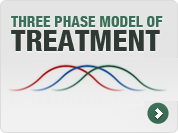The risk factors for developing BPD are genetic (the average heritability of BPD is 60%) and environmental (40%). Therefore, treatment is usually most effective when both medications and psychotherapy are used simultaneously. Recent research findings have significantly altered the recommended treatment of borderline disorder with medications 27 and psychotherapy.28 The purpose of the Three Phase Model is to describe clearly their integrated use in BPD as treatment evolves. The model spans the entire course of treatment and defines how the relative emphasis of medications and psychotherapy changes during the treatment process.
This model provides my patients and their families with a roadmap of the entire course of treatment. It enables them to better understand the goals and tasks of treatment: those at hand; the ones ahead; and those accomplished if treatment has already begun.
PHASE 1
In Phase 1, it is important to have located a psychiatrist who is skilled in the treatment of borderline disorder. This is so because medications are the first line of treatment for many of the core symptoms of borderline disorder, 27 and those symptoms related to most co-occurring disorders. Those medications that are most effective for you are determined mainly by your primary symptoms and by your specific biological makeup. There are three major benefits of prompt treatment with medications. First, some symptoms of borderline disorder, such overreactive emotional responses, for example anger, and assaultive behaviors directed at oneself and others respond slowly to therapy. Second, other symptoms, such as suspiciousness, paranoid thinking and split thinking are only responsive to medications. Third, in this first phase of treatment, psychotherapy serves an important, adjunctive role, achieving its initial objectives by using general methods that are common to most types of BPD-specific therapy. Clinical experience uniformly suggests that medications enable patients to respond more promptly and fully to psychotherapy. In phase 1, your most pressing problem will be to locate in your vicinity a therapist skilled and experienced in any form of BPD-specific therapy. It is a bonus if your therapist also has the flexibility to adopt and use those specific methods used in different forms of therapy that would be additionally beneficial in your case.
PHASE 2
As treatment progresses to Phase 2, psychotherapy becomes the primary focus of treatment. Medications assume an adjunctive role, and the doses are fine-tuned according to your needs. Ideally, the general, common methods of therapy are continued as needed, and the methods that are specific to the different forms of therapy which are currently in use will also be employed flexibly as determined by your personal needs. For most patients, this phase of treatment is usually about one to two years in duration, but may be longer.
PHASE 3
The concluding phase of treatment focuses on consolidating the gains made in the initial two phases. This consolidation primarily involves your learning to apply the new skills you have acquired in therapy to resolve your challenges and difficulties with minimal help from your therapist. In this phase of treatment, it is not uncommon to observe that many patients require lower doses of, and fewer medications. Eventually, some patients may not require medications at all, except during times of unusual stress, or for the treatment of chronic, co-occurring disorders such as ADHD and major depressive episodes. As you become more skilled and self-sufficient, the frequency of psychotherapy also declines. Ultimately, therapy is only used as needed during periods of crises or significant life-changes.
To best understand the interaction of medications and psychotherapy in the treatment of borderline disorder, it is important to know some additional facts about each. You can readily gain access to this information on these website pages: Medications; Psychotherapy.






